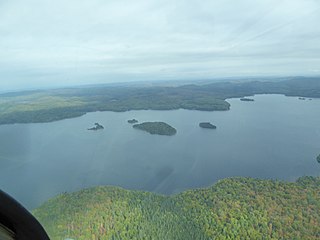
The Metabetchouan River is a tributary of Lac Saint-Jean in the centre of the province of Quebec, Canada. The course of this river successively crosses the regional county municipalitys (MRC) of:

La Tuque is a city located in north-central Quebec, Canada, on the Saint-Maurice River, between Trois-Rivières and Chambord. The population was 11,129 at the 2021 Canadian census, most of which live within the urban area. At over 28,000 km2 (11,000 sq mi), it is the largest city in Canada by area.

La Bostonnais is a municipality in the Mauricie region of the province of Quebec in Canada. The community is about 10 kilometres (6.2 mi) north of La Tuque's town centre along Quebec Route 155.
Batiscanie is the watershed of the Batiscan River, located in the center of the province of Quebec, Canada, covering 4690 km² on the North Shore of the St. Lawrence River. The area covered by Batiscanie is 53% in the administrative région of Mauricie and 47% in the administrative region of the Capitale-Nationale.
The Batiscan Lake is located in Upper Batiscanie and is the limit of unorganized territories of Lac-Blanc and Lac-Croche. This territory is related to the La Jacques-Cartier Regional County Municipality, in the administrative region of the Capitale-Nationale, in the province of Quebec, Canada.

The Wayagamac Lake is located in the city of La Tuque in La Tuque, in Mauricie, in Quebec, in Canada. Until 2006, the territory of the lake was part of the former unorganized territory of Petit-Lac-Wayagamac, before being merged to the La Tuque. The area of the lake is administered by the Zec de la Bessonne.

The river Bostonais or Bostonians is a river of Canada, located in Quebec, in the administrative region of Mauricie, in La Tuque.
The Grand Lake Bostonnais is located in the La Tuque, in the administrative region of Mauricie, in Quebec, Canada. This lake is an important body of water is feeding the Bostonnais River which pours at La Tuque in Saint-Maurice River. The territory around Grand Lake Bostonnais is entirely in forest.
The lac Ventadour is the main headwater lake of the Bostonnais River. This lake is located in the La Tuque, in Mauricie, in Quebec, in Canada. The area around the lake is mostly administered by the Zec Kiskissink.
The Lake Lescarbot is located in the La Tuque, in Mauricie, in Quebec, in Canada. The territory is administered by Zec Kiskissink.
The Zec de la Bessonne is a "zone d'exploitation contrôlée" (ZEC) near La Tuque in administrative region of Mauricie, in Quebec, in Canada. A territory of 524.5 square kilometres (202.5 sq mi) was assigned in 1978 to the Zec.
The Zec Kiskissink is a "zone d'exploitation contrôlée" (zec), located in the administrative region of the Mauricie, the Capitale-Nationale and Saguenay-Lac-Saint-Jean, in Quebec, in Canada. This wild territory, used for recreative activities is managed by the "Sacerf Macousine Association".
The ZEC Wessonneau is a "zone d'exploitation contrôlée" (ZEC), located on the west bank of the Saint-Maurice River, in the La Tuque, in the region the Mauricie, in Quebec (Canada). This public hunting and fishing area is managed by the "Association chasse et pêche Fléchée Inc".
The ZEC Borgia is a "zone d'exploitation contrôlée" (ZEC) located in La Tuque, in administrative region of Mauricie, Quebec, Canada.
The Zec Ménokéosawin is a "zone d'exploitation contrôlée", located in the region of Mauricie, in Quebec, Canada. This public hunting and fishing area is managed by the "Association de chasse-pêche de la rivière Bostonnais Nord", a non-profit organization.
The Cinconsine Lake is located on the west bank of the Saint-Maurice River in the territory of La Tuque, in Mauricie, in Quebec, in Canada. The area surrounding the lake is part of the northern part of the Zec Wessonneau.
Mauricie tourism represents an important sector of Québec’s economy with 1.2 to 1.5 million visitors each year who spend 200 to 300 million dollars per year in tourist attractions and services. In 2011, 90% of tourists in Mauricie were Quebecers, 3% came from other Canadian provenances, 2% from the United States, and 4% from others.
The lac Métabetchouane is a fresh body of water crossed by the Métabetchouane River, in the unorganized territory of Lac-Moncouche, in the Lac-Saint-Jean-Est Regional County Municipality, in the administrative region of Saguenay–Lac-Saint-Jean, in the province in Quebec, to Canada. This lake constitutes the demarcation between the Laurentides Wildlife Reserve and zec Kiskissink.
The lac Saint-Henri is a freshwater body crossed by the Métabetchouane River, in the unorganized territory of Lac-Croche, in the La Jacques-Cartier Regional County Municipality, in the administrative region of Capitale-Nationale, in the province of Quebec, in Canada. This lake is located in the Laurentides Wildlife Reserve.
The Petit lac Wayagamac is located in the city of La Tuque, in Mauricie, in Quebec, in Canada. Until 2006, the territory of this lake was part of the former unorganized territory of Petit-Lac-Wayagamac, before being merged with La Tuque. The territory of the lake is controlled by the Zec de la Bessonne.






